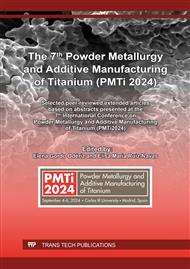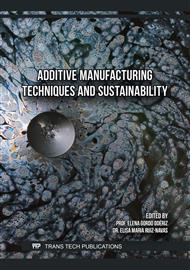[1]
S. Yin, P. Cavaliere, B. Aldwell, R. Jenkins, H. Liao, W. Li, et al., Cold spray additive manufacturing and repair: Fundamentals and applications, Additive Manufacturing 21 (2018) 628-50.
DOI: 10.1016/j.addma.2018.04.017
Google Scholar
[2]
R. Vaz, A. Garfias, V. Albaladejo, J. Sanchez, I. Cano, A Review of Advances in Cold Spray Additive Manufacturing, Coatings 13 (2023).
DOI: 10.3390/coatings13020267
Google Scholar
[3]
W. Li, K. Yang, S. Yin, X. Yang, Y. Xu, R. Lupoi, Solid-state additive manufacturing and repairing by cold spraying: A review, J Mater Sci Technol 34 (2018) 440-57.
DOI: 10.1016/j.jmst.2017.09.015
Google Scholar
[4]
A. Papyrin, V. Kosarev, S. Klinkov, A. Alkhimov, V.M. Fomin, Cold Spray Technology: Elsevier Science; 2006.
DOI: 10.1016/b978-008045155-8/50003-x
Google Scholar
[5]
V.F. Kosarev, S.V. Klinkov, A.P. Alkhimov, A.N. Papyrin, On some aspects of gas dynamics of the cold spray process, J Therm Spray Technol 12 (2003) 265-81.
DOI: 10.1361/105996303770348384
Google Scholar
[6]
M. Grujicic, C.L. Zhao, W.S. DeRosset, D. Helfritch, Adiabatic shear instability based mechanism for particles/substrate bonding in the cold-gas dynamic-spray process, Mater Design 25 (2004) 681-8.
DOI: 10.1016/j.matdes.2004.03.008
Google Scholar
[7]
T. Hussain, Cold Spraying of Titanium: A Review of Bonding Mechanisms, Microstructure and Properties, Key Eng Mater 533 (2013) 53-90.
DOI: 10.4028/www.scientific.net/kem.533.53
Google Scholar
[8]
H. Assadi, F. Gartner, T. Stoltenhoff, H. Kreye, Bonding mechanism in cold gas spraying, Acta Materialia 51 (2003) 4379-94.
DOI: 10.1016/s1359-6454(03)00274-x
Google Scholar
[9]
S.H. Zahiri, C.I. Antonio, M. Jahedi, Elimination of porosity in directly fabricated titanium via cold gas dynamic spraying, Journal of Materials Processing Technology 209 (2009) 922-9.
DOI: 10.1016/j.jmatprotec.2008.03.005
Google Scholar
[10]
M. Faizan-Ur-Rab, S.H. Zahiri, S.H. Masood, M. Jahedi, R. Nagarajah, PIV Validation of 3D Multicomponent Model for Cold Spray Within Nitrogen and Helium Supersonic Flow Field, J Therm Spray Technol 26 (2017) 941-57.
DOI: 10.1007/s11666-017-0567-0
Google Scholar
[11]
M. Faizan-Ur-Rab, S.H. Zahiri, P.C. King, C. Busch, S.H. Masood, M. Jahedi, et al., Utilization of Titanium Particle Impact Location to Validate a 3D Multicomponent Model for Cold Spray Additive Manufacturing, J Therm Spray Technol 26 (2017) 1874-87.
DOI: 10.1007/s11666-017-0628-4
Google Scholar
[12]
M. Faizan-Ur-Rab, S.H. Zahiri, S.H. Masood, M. Jahedi, R. Nagarajah. 3D CFD Multicomponent Model for Cold Spray Additive Manufacturing of Titanium Particles, in CFD Modeling and Simulation in Materials Processing 2016, Springer Cham, (2016), 213-20.
DOI: 10.1002/9781119274681.ch26
Google Scholar
[13]
M.F.U. Rab, S. Zahiri, S.H. Masood, M. Jahedi, R. Nagarajah, Development of 3D Multicomponent Model for Cold Spray Process Using Nitrogen and Air, Coatings 5 (2015) 688-708.
DOI: 10.3390/coatings5040688
Google Scholar
[14]
P.C. King, S. Gulizia, A.J. Urban, J.E. Barnes, Process for producing a preform using cold spray United States Patent 2017/0157671 A1 (2017).
Google Scholar
[15]
S.M. Mousavi, E. Roohi, Three dimensional investigation of the shock train structure in a convergent–divergent nozzle, Acta Astronautica 105 (2014) 117-27.
DOI: 10.1016/j.actaastro.2014.09.002
Google Scholar
[16]
H. Jafari, S. Emami, Y. Mahmoudi, Numerical investigation of dual-stage high velocity oxy-fuel (HVOF) thermal spray process: A study on nozzle geometrical parameters, Applied Thermal Engineering 111 (2017) 745-58.
DOI: 10.1016/j.applthermaleng.2016.09.145
Google Scholar
[17]
M. Faizan-Ur-Rab, S.H. Zahiri, S.H. Masood, T.D. Phan, M. Jahedi, R. Nagarajah, Application of a holistic 3D model to estimate state of cold spray titanium particles, Mater Design 89 (2016) 1227-41.
DOI: 10.1016/j.matdes.2015.10.075
Google Scholar
[18]
Y. Jiang, Q. Zheng, P. Dong, J. Yao, H. Zhang, J. Gao, Conjugate heat transfer analysis of leading edge and downstream mist–air film cooling on turbine vane, International Journal of Heat and Mass Transfer 90 (2015) 613-26.
DOI: 10.1016/j.ijheatmasstransfer.2015.07.005
Google Scholar
[19]
A. Proskurin, Y. Zheglova, Ansys CFX Study of Aerodynamic Characteristics during Blade Profile Rotation, International Journal for Computational Civil and Structural Engineering 17 (2021) 153-60.
DOI: 10.22337/2587-9618-2021-17-4-153-160
Google Scholar
[20]
R.R. Salakhov, A. Ermakov, E. Gabdulkhakova, Numerical and Experimental Study of the Impeller of a Liquid Pump of a Truck Cooling System and the Development of a New Open-Type Impeller, Tehnički glasnik 14 (2020) 135-42.
DOI: 10.31803/tg-20200309115417
Google Scholar
[21]
P. Dhopade, A.J. Neely, Aeromechanical Modeling of Rotating Fan Blades to Investigate High-Cycle and Low-Cycle Fatigue Interaction, Journal of Engineering for Gas Turbines and Power 137 (2015) 052505.
DOI: 10.1115/1.4028717
Google Scholar
[22]
S. Gulizia, A. Trentin, S. Vezzu, S. Rech, P. King, M. Jahedi, et al., Characterisation of Cold Spray Titanium Coatings, In: Nie JF, Morton A, editors. PRICM7 Durnten-Zurich: Trans Tech Publications Ltd; 2010. pp.898-901.
DOI: 10.4028/www.scientific.net/msf.654-656.898
Google Scholar
[23]
Information on https://www.matweb.com/search/datasheet_print.aspx?matguid=66f20965748441d8916768ed80be0cba.
Google Scholar
[24]
H. Zhou, Microstructure control and properties of cold-sprayed titanium and its alloy coatings, Materials Science and Technology 37 (2021) 121-43.
DOI: 10.1080/02670836.2020.1868689
Google Scholar
[25]
M. Rezaee, A. Zarei-Hanzaki, A. Mohamadizadeh, E. Ghasemi, High-temperature flow characterization and microstructural evolution of Ti6242 alloy: Yield drop phenomenon, Materials Science and Engineering: A 673 (2016) 346-54.
DOI: 10.1016/j.msea.2016.07.043
Google Scholar



